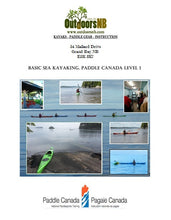2 Day Course.
The course fee does not include a kayak rental for the course. Course attendees are encouraged to bring their own boats or facilitate a rental with us prior to the course. If a rental is required please contact us and we will facilitate.
OutdoorsNB is very proud to offer the Paddle Canada Level 1 Sea Kayaking course in Grand Bay-Westfield. Join Coach Jeremy Cline as he teaches safe and efficient kayaking. We want to inform and engage you, heighten your awareness of the environment you will paddle in and teach you how to plan a safe trip.
In this 2 day course we will cover:
The extent of knowledge required for safe paddling at this level is governed by the conditions within a sheltered bay. The following list is not exhaustive and is provided here as a guide to the nature and extent of knowledge necessary for safe and enjoyable paddling in a level-1 environment.
Equipment
Demonstrate basic knowledge of the features and attributes of equipment, including:
- Transport Canada equipment requirements
- Sea kayak, paddle and spray skirt designs
- Bailing devices
- Lifejacket and clothing
- Rescue Equipment
Skills
Paddling skills - It is important to master the skills for calm water in this level:
- Lift and carry - Use proper body mechanics to prevent injury while moving a kayak.
- Launching & Landing - Demonstrate launching and landing in sheltered conditions off a beach or dock.
- Forward paddling - Demonstrate efficient forward paddling, with good speed and control over 100 meters. Show good upright posture, torso rotation, extended front arm.
- Stopping - Travel at a moderate speed then stop the kayak within 2 strokes (count one side).
- Reverse paddling - Demonstrate controlled reverse paddling while looking back for a clear and safe route. Show good torso rotation.
- Sweep strokes - From a static start, turn the kayak 360 degrees. Use a combination of forward and reverse sweep strokes. Show efficient placement of the paddle and unwinding of the trunk. While moving forward at good speed, turn the kayak with a forward sweep stroke and edging.
- Edge control - The paddler will demonstrate beginnings of good edging control that assists turning.
- Draw stroke - From a static start, move the kayak sideways 2 meters, using the draw stroke and the sculling draw stroke. While moving forward, move the kayak sideways using a draw stroke.
- Low & high brace - The paddler will demonstrate an understanding of correct technique to prevent a capsize with a low and a high brace.
- Stern rudder - Use the stern rudder stroke to turn the kayak in calm conditions.
Rescue skills - Rescue skills are your first line of defense in the event of an incident. These skills are arguably the most important skills you can learn for group outings:
- Bow rescue - Demonstrate a confident capsize and attract attention by banging on the hull. The rescuer will move in from 5 meters away but should not approach at right angles to where the hands or body are located. The victim must show confidence and control; bow, stern, side or paddle presentation may be used.
- Assisted rescues - In deep water, wet-exit and re-enter the kayak with assistance from another paddler. The capsize must be natural with spray deck in place. Rescue is complete when the excess water is removed from the cockpit, the swimmer is back in the boat, the spray skirt is attached and the paddler has regained sufficient stability to paddle effectively. The participant will demonstrate as both swimmer and rescuer. Participants should have the opportunity to practice both the T-rescue and the raft, re-enter and pump techniques.
- Unassisted re-entry - Wet exit and re-enter a kayak in deep water. Aids such as a paddle float may be used.
- Contact tow - Demonstrate a simple contact tow without the use of a towline.
We offer many of the required paddling gear items at our shop.
Location
Courses will be offered at Nerepis Marsh (with Rockwood Park as an alternate in case of wind).
If all participants have the required cold water gear then Deer Island will be available as an alternate option.
Instructor
Jeremy Cline
Education: Mechanical Engineering Technology
Paddle Canada Level 1 Sea Kayak Certification
Paddle Canada Level 2 Sea Kayak Certification
Paddle Canada Level 3 Sea Kayak Certification
Paddle Canada Intro to Sea Kayaking Instructor Certification
Paddle Canada Level 1 Sea Kayak Instructor Certification
Paddle Canada Level 2 Sea Kayak Instructor Certification
Industry Canada Global Marine Distress Safety System Restricted Operator VHF Certification
Transport Canada Marine Emergency Duties A2 Certification
Transport Canada Chart Work and Pilotage 061
Transport Canada Navigational Electronics
Red Cross Medical First Responder
Stanford University: Humanities Sciences EP101 Your Body in the World




